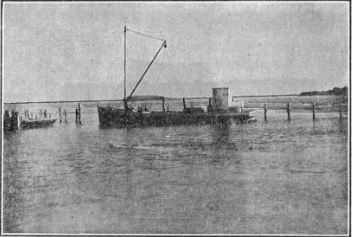234. Selling To The Consumer
Description
This section is from the book "Vegetable Gardening", by Ralph L. Watts. Also available from Amazon: Vegetable Gardening.
234. Selling To The Consumer
When a limited area is cultivated it is often an advantage to sell direct to the consumer, because the gross receipts will be larger than when selling at wholesale. The most common methods are to sell from house to house or in a city retail market. When either of these plans is used, it is mainly a question whether the time of man and team when thus engaged are worth more than when employed at home in giving the crops better care or in cultivating a larger area. It is doubtless true that many gardeners minimize profits by spending too much time seeking buyers of small lots.

Fig. 57. MOTOR BOAT USED BY A LONG ISLAND MARKET GARDENER.
When selling from house to house it is imperative that the goods be first-class in every particular, and thus make it possible to build up a regular trade. To retain customers it is also important to make trips every week throughout the year. It may be necessary to go daily in the summer and from one to three times a week at other seasons. Since consumers must not be disappointed, promptness and regularity count for much in retaining trade. A variety and a succession of vegetables are important factors, whatever the method of selling may be.
Retail wagons should be built especially for the purpose (230). A covered wagon for the protection of salesman and vegetables is highly desirable. A Minnesota gardener's wagon is provided with a gong, and the salesman also furnishes his customers with large printed cards placed in the windows whenever vegetables are wanted. With the cards and the gong very little time is lost in getting buyers to the wagon.
Many cities have retail markets where farmers and gardeners are privileged to place their wagons and sell to the consumers. When this method is followed the gardener should always occupy the same place so that regular customers will know just where to find him. It is not so important to carry an assortment of vegetables. It is often an advantage to make a specialty of a few which may be grown to a high degree of perfection. The gardener will soon become well known for these particular crops.
Some gardeners living in the suburbs of cities sell large quantities of vegetables in the field or in the packing shed. The plan is satisfactory, provided waiting on the customers does not interfere too much with the work that may be in progress.
H. B. Fullerton of Long Island has developed a plan of shipping to consumers in large cities, mainly New York. Figure 50 shows the Long Island hamper packed with an assortment of vegetables. The two layers of three 4-quart baskets are separated by a division rack. Before packing, thin paraffin paper is cut in sizes large enough to line the boxes and to lap over the top and cover the vegetables. An assortment of about nine vegetables is sent in each hamper. After business has been established with a family, a preference is often expressed for certain vegetables, and not more than three to five vegetables may be included in subsequent shipments. The aim, however, is to supply city consumers with an assortment of vegetables just as good, clean and fresh as country people enjoy. Early in the spring the hampers are packed with lettuce, radishes, spinach, rhubarb and root crops held over winter. Later, many other vegetables are available, and a full and varied assortment is furnished as the season advances. The hampers are loaded on express trains in the morning and reach the city home in time for dinner. The uniform price the year round is $1.50 a hamper delivered.
Continue to:
Tags
plants, crops, gardening, cultivated, harvesting, food ,greenhouses, fertiliser, vegitables
